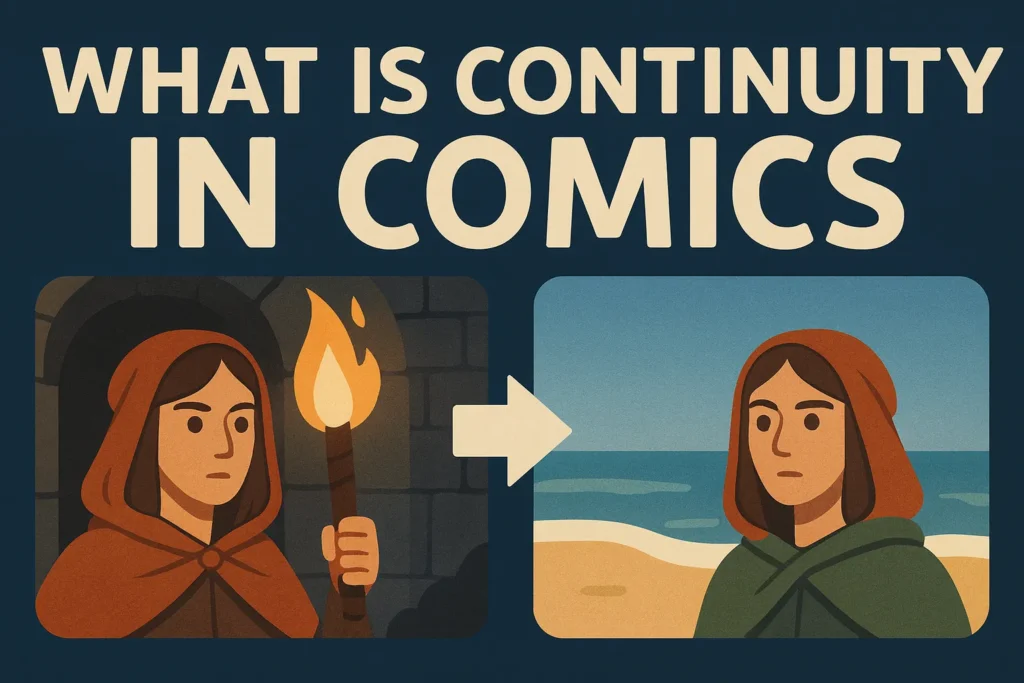
What Is Comic Book Continuity?
Table of Contents
Table of Contents
In storytelling, continuity refers to the logical and consistent connection between elements of a narrative over time—characters, settings, timelines, events, and even visual details. When continuity is maintained, stories feel coherent, immersive, and believable. When it’s broken—intentionally or by accident—it can cause confusion, break immersion, or pull readers out of the experience.
At its core, continuity is what ensures that:
- Characters behave according to their established personalities.
- Events unfold with a clear cause-and-effect logic.
- Settings and timelines remain consistent from scene to scene or issue to issue.
Why Continuity Is Important
Even in the most imaginative stories, continuity is what makes the world feel real. It preserves the internal logic of a fictional universe—whether it’s a grounded family drama or a sprawling multiverse of superheroes. Without continuity:
- Characters can behave erratically.
- Plot holes may emerge.
- Audiences can lose trust in the narrative.
This is especially important in long-running or serialized stories—like comic books, television shows, and cinematic universes—where multiple writers, artists, or directors may contribute across months or even decades.
Why Continuity Matters More in Long-Running Series
In short-form storytelling (like a one-shot novel or short film), continuity can be tightly controlled from beginning to end. But in ongoing narratives, maintaining continuity becomes more complex—and more critical.
- In comic book universes like Marvel or DC, characters may appear across multiple titles, written by different creative teams. A change in one series can ripple across dozens of others.
- In film franchises, a continuity misstep between sequels (like a character appearing to die, only to return with no explanation) can break audience engagement.
- In episodic TV, viewers binge-watch with a high attention to detail—making inconsistencies in costume, backstory, or setting easier to notice.
Examples of Continuity in Popular Media
- Books: In Harry Potter, continuity ensures that magical rules (like the use of Time Turners or Horcruxes) stay consistent across seven books, despite a growing and evolving world.
- Comics: In Spider-Man comics, Peter Parker’s trauma over Uncle Ben’s death continues to shape his decisions hundreds of issues later. Breaking that continuity would damage the character’s core.
- Movies: The Marvel Cinematic Universe (MCU) has built an interconnected world across more than 30 films. Continuity between characters (like Tony Stark’s arc from Iron Man to Endgame) is what makes the emotional payoffs satisfying.
- TV: In Breaking Bad, meticulous continuity—from character wounds to car damage—enhances realism and viewer trust.
Continuity isn’t just about avoiding mistakes—it’s about maintaining a living, breathing world that audiences can invest in. In the next sections, we’ll explore how timelines support continuity, when it’s okay to break the rules, and how great stories strike a balance between consistency and creative freedom.
1. Why Continuity Matters in Storytelling
At its foundation, continuity is the glue that holds a narrative together. Whether you’re writing a short story, a multi-season TV series, or an interconnected comic universe, maintaining internal logic is essential. Continuity helps readers and viewers stay grounded, allowing them to fully invest in the story and its world.
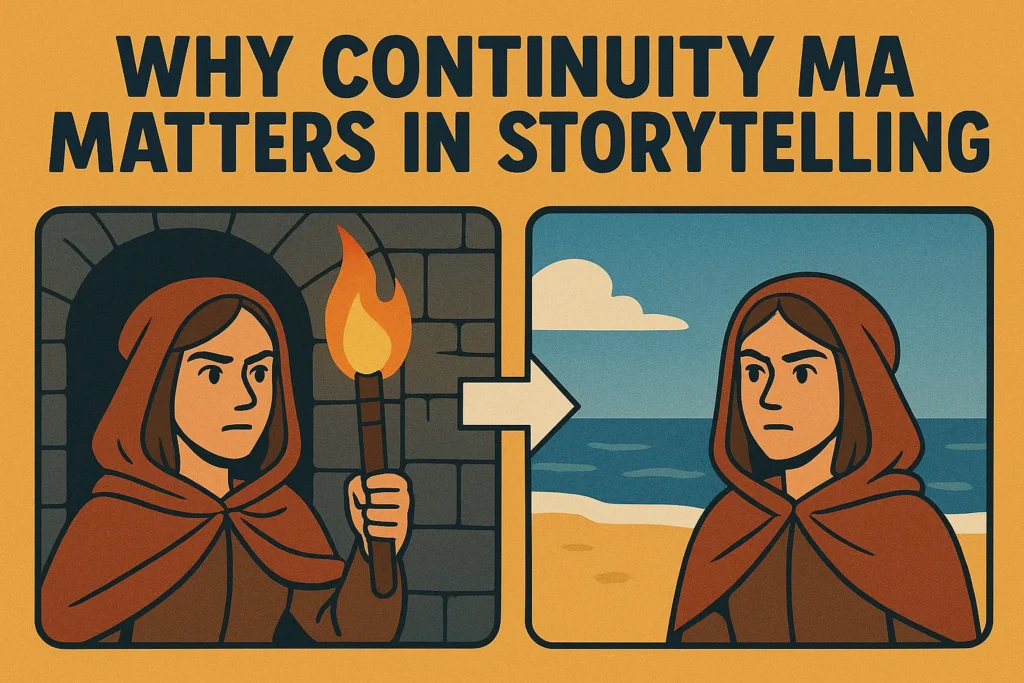
Here are the core reasons why continuity is so important—and what happens when it’s broken:
1. Logical Progression
Good storytelling depends on cause and effect. When an event happens in a story, readers expect the next event to follow logically. Characters must react in believable ways, and developments must build upon each other over time.
Example: If a character is severely injured in one chapter, they shouldn’t be running marathons in the next—unless that’s explained.
Continuity ensures:
- Character growth happens step by step
- Plot twists feel earned, not random
- Conflicts escalate naturally
2. Audience Immersion and Trust
Audiences are smarter and more observant than ever. Inconsistencies—whether visual (a missing scar), narrative (a forgotten event), or emotional (a character acting out of sync)—can shatter immersion.
“Didn’t he say he hated flying? Why is he piloting a jet now with no explanation?”
When continuity is respected, readers trust the storyteller. That trust allows them to stay focused on the story instead of questioning what’s missing or off.
3. Franchise Consistency (Comics, TV, and Film)
Continuity becomes increasingly complex—and vital—when stories span multiple works, creators, or formats. This is especially true in:
- Comic book universes (e.g., Marvel, DC)
- Cinematic franchises (e.g., Star Wars, the MCU)
- Television series with multi-season arcs (e.g., Game of Thrones, Lost)
In these formats, audiences expect continuity to be tracked across time, settings, characters, and even spin-offs. That’s why many companies use continuity editors, bibles, and showrunners to maintain coherence.
Example: Marvel Studios tracks every character’s arc across films. Iron Man’s PTSD in Iron Man 3 only works because of continuity from The Avengers.
What Happens When Continuity Breaks?
When continuity fails, the story risks:
- Plot holes (missing explanations or logic gaps)
- Character inconsistency (emotional whiplash, out-of-character decisions)
- Franchise confusion (contradictions between movies/shows/books)
- Fan backlash and breakdown of narrative trust
Even a small inconsistency can snowball in large fandoms or serialized storytelling, especially when fans share timelines and theories online.
Continuity isn’t about being strict or technical—it’s about respecting the reader’s investment. When details align across characters, scenes, and story arcs, stories become immersive, character arcs feel earned, and plot progression resonates emotionally. In serialized media, it’s the backbone of long-term engagement.
2. Why Timelines Matter in Continuity
While continuity ensures a story stays logically consistent, timelines are the tool that keeps that consistency in order. A timeline maps out the chronological sequence of events, helping writers manage cause and effect, character arcs, and world-building across scenes, chapters, or even an entire franchise.
For creators, timelines are more than a visual aid—they’re essential for avoiding contradictions, building emotional resonance, and delivering satisfying narrative flow.
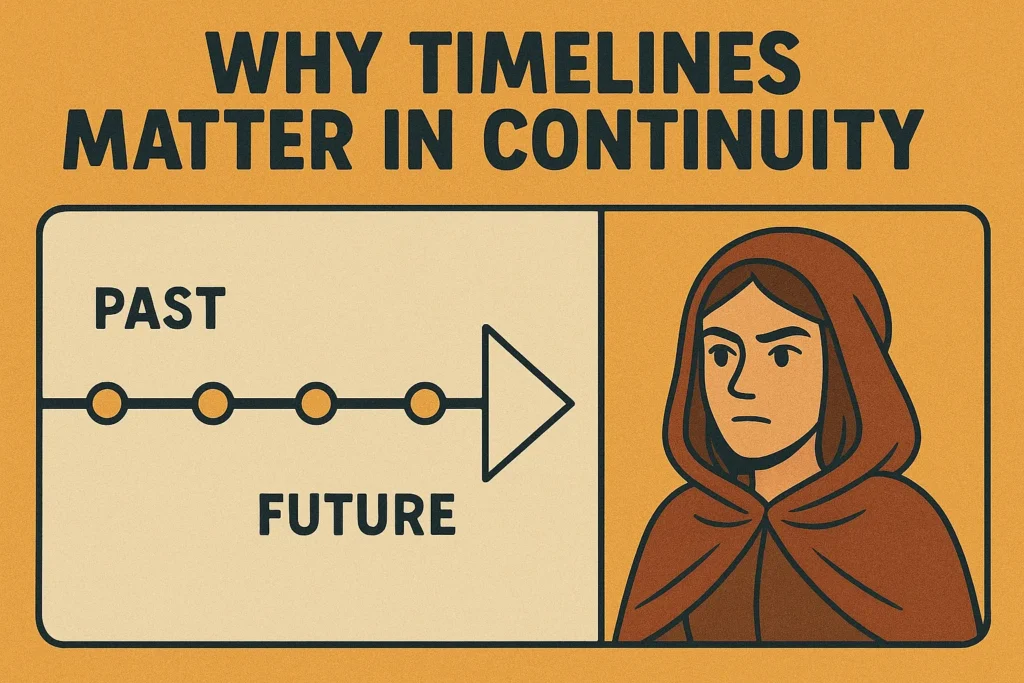
1. Clarity and Reader Orientation
When a story unfolds in chronological order—or makes clear when and where events are happening—readers stay grounded. They understand what came before, what’s happening now, and what’s likely to come next.
Example: If Chapter 10 takes place “three months later,” the story must reflect what’s happened in those months—emotionally, physically, and relationally.
A strong timeline avoids reader confusion and keeps them immersed.
2. Logical Cause and Effect
Every story is built on consequences. A character’s decision in one scene might spark a major event in the next—but that connection only works if the sequence makes sense.
Example: If a villain’s attack destroys a city, a later scene shouldn’t show that same city unharmed—unless it’s been rebuilt, and that’s acknowledged.
Timelines help writers ensure that:
- Actions lead to consequences
- Events escalate in a believable order
- Clues or foreshadowing land effectively
3. Character Development Depends on Time
Characters evolve over time—mentally, emotionally, and physically. A well-managed timeline lets you track:
- Grief and healing
- Relationship changes
- Skill growth or loss
- Internal transformation
Example: In Harry Potter, each book aligns with a school year. This timeline structure allows readers to track Harry’s growth and emotional state as time passes.
Without a timeline, character arcs can feel rushed, flat, or inconsistent.
4. Writing & Editing Made Easier
Timelines are a critical tool for writers and editors, especially in complex plots with:
- Multiple POVs
- Flashbacks and time jumps
- Interwoven subplots
- Ensemble casts
Tools like spreadsheets, plotting software, whiteboards, and sticky-note timelines help keep events, character arcs, and world events aligned—especially useful in revision.
A clear timeline can prevent months of rewriting and fix continuity holes before they show up.
5. World-Building and Continuity in Franchises
In shared universes like comics or cinematic sagas, timelines aren’t optional—they’re strategic assets. Studios and publishers often maintain internal timeline documents (aka “story bibles”) to track:
- Character ages and appearances
- Key universe events (wars, deaths, revelations)
- Technological or historical developments
Example: Marvel’s Cinematic Universe keeps a Master Timeline to ensure continuity between movies, shows, and post-credits scenes. Without it, contradictions would pile up quickly.
A timeline doesn’t just show when things happen—it shapes how stories feel, flow, and pay off. Whether you’re planning a novel, a comic series, or a show, keeping track of time helps you:
- Build realistic characters
- Avoid logic gaps
- Deepen emotional storytelling
- Maintain immersive, consistent continuity
Time matters in fiction—not just to the characters, but to the audience watching them grow.
3. When to Break Timelines (And Why You Might Want To)
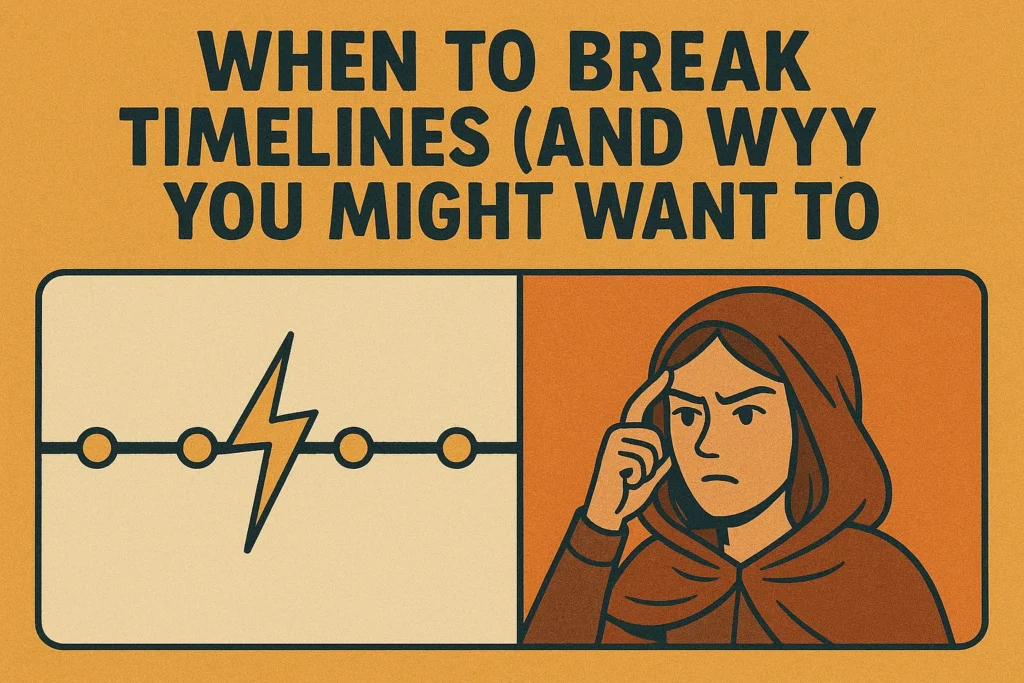
While continuity and chronological structure are essential tools in storytelling, sometimes breaking the timeline—or even bending continuity—can elevate a narrative rather than disrupt it.
Many great stories intentionally ignore strict chronology or cause-and-effect flow to build mystery, enhance theme, or reflect the fragmented reality of their characters. When used skillfully, these techniques can turn a linear story into something emotionally or intellectually richer.
Here’s how (and why) authors and screenwriters do it:
1. Non-Linear Storytelling
Jumping back and forth in time can build suspense, create emotional contrast, or reveal important information later—when it has more impact.
Example: Christopher Nolan’s Memento tells its story backward to mimic the main character’s memory loss, creating a puzzle the audience solves as the film unfolds.
Non-linear techniques often include:
- Flashbacks and flash-forwards
- Out-of-sequence chapters or scenes
- Fragmented chronology
Also seen in:
- The Witcher (Season 1) – timelines rearranged to introduce multiple characters
- Slaughterhouse-Five – jumps through time to reflect the trauma of war
2. Thematic or Emotional Structure
Some stories prioritize emotional beats over chronological progression. Rather than following a straight timeline, scenes are arranged to mirror:
- Grief stages
- Symbolic or cyclical patterns
- Parallel character arcs
Example: Pixar’s Inside Out uses emotional logic, not real-time logic, to guide its structure—flashing between memory islands and emotional shifts.
This technique favors resonance over realism, which can make the story feel more poetic or powerful, even if events are “out of order.”
3. Unreliable Narration
In stories told by an unreliable narrator, the timeline might be intentionally warped or hidden. This mimics:
- Memory loss
- Denial
- Delusion or mental illness
- Intentional deception
Example: Fight Club breaks timeline expectations by revealing that one narrator is actually two people—changing our understanding of earlier events.
This forces readers to reconstruct the real story themselves, adding depth and interactivity to the experience.
4. Artistic or Experimental Storytelling
Avant-garde or postmodern stories often break timelines and continuity on purpose—not to confuse the audience, but to invite deeper interpretation.
Example: House of Leaves fragments time, space, and perspective to reflect the psychological breakdown of its characters.
Other examples:
- Graphic novels with mirrored panel layouts or dual timelines
- Films that repeat scenes with alternate outcomes (Run Lola Run, The Butterfly Effect)
- Novels where the ending reshapes the beginning (Cloud Atlas)
These works challenge traditional storytelling—asking audiences to participate by assembling meaning from the fragments.
When Breaking Timelines Doesn’t Work
While creative disruptions can be powerful, they need clarity anchors:
- Visual or typographic cues (like different fonts for flashbacks)
- Chapter dates, time stamps, or transitions
- Characters’ ages or setting changes that cue time shifts
Without these, readers can become confused, frustrated, or disengaged.
Pro tip: If you break the timeline, make sure you teach the reader how to read your story.
Summary
Timelines are a powerful storytelling tool—but they’re not a cage. Breaking, bending, or rearranging time can unlock:
- Deeper emotional resonance
- Thematic layering
- Complex character exploration
- Audience participation
Just like real memory, storytelling doesn’t have to follow a straight line. Sometimes, it’s what we remember—and when—that shapes the story best.
4. How Writers Maintain Continuity in Practice
Maintaining strong continuity over the course of a novel, screenplay, comic series, or cinematic universe isn’t just about memory—it’s about systems. Professional writers and storytellers rely on a combination of tools, techniques, and team roles to track story details and prevent inconsistencies before they slip through the cracks.
Whether you’re an indie novelist or part of a billion-dollar studio, here’s how continuity is actively managed in practice:
1. Story Bibles
A story bible is a central document (or digital archive) that tracks key elements across a narrative. It includes:
- Character profiles (age, backstory, goals, quirks)
- Setting descriptions (geography, weather, rules of magic/science)
- Major events and their consequences
- Timeline of key plot developments
Used by: Screenwriters, novelists, comic creators, TV showrunners
Example: The Game of Thrones production team maintained a massive internal bible to track family trees, house alliances, languages, and geography.
2. Continuity Editors & Script Supervisors
In professional productions, continuity is someone’s full-time job.
Script Supervisor (Film/TV):
Tracks:
- Costume changes
- Prop placement
- Weather/lighting consistency
- Character injuries or physical states
Example: In long shooting schedules, a character might film a scene “after the explosion” before filming the explosion itself—so the supervisor ensures the makeup, dirt, or limp matches.
Continuity Editor (Comics & Books):
- Ensures events, relationships, and powers stay aligned across issues or volumes
- Flags contradictions in plot, dialogue, or character arcs
- Works closely with writers and editorial teams
Example: Marvel Comics has had entire editorial departments focused on continuity. Stan Lee even handed out “No-Prizes” to fans who spotted continuity errors that could be creatively explained!
3. Visual Timelines and Plotting Boards
Writers often create visual timelines using:
- Sticky notes
- Whiteboards
- Plotting software (e.g., Plottr, Scrivener, Notion)
- Excel/Google Sheets
These help map:
- Parallel character arcs
- Scene chronology
- Flashbacks vs present-day
- Event pacing across chapters or episodes
Example: Many authors use color-coded sticky notes on a board to move scenes around while preserving continuity—especially helpful when juggling multiple POVs or timelines.
4. Revision Loops and Continuity Passes
After drafting, many writers do at least one “continuity pass”—a read-through focused solely on consistency. This includes checking:
- Dialogue alignment with earlier scenes
- Character knowledge (what do they know and when?)
- Time-of-day, weather, or injuries across scenes
- Chapter order vs timeline logic
Tip: Keep a running log of in-story days, injuries, locations, and emotional beats while revising.
5. Collaborative Worldbuilding Tools
In shared storytelling environments—such as writers’ rooms, D&D campaigns, or comic publishing houses—collaborative tools help teams stay aligned:
- World Anvil (for fantasy/sci-fi world tracking)
- Google Docs or Notion (shared references)
- Trello/Asana for narrative task tracking
- Fandom Wikis (yes, even creators use fan-made timelines!)
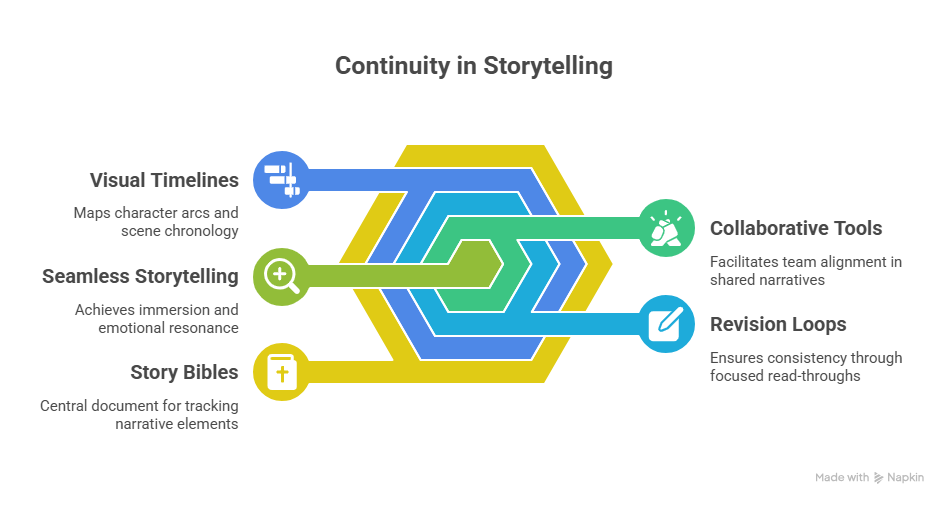
Marvel and Star Wars writers often consult fan wikis to double-check obscure continuity before writing new content.
Summary
Continuity doesn’t happen by accident—it’s tracked, tested, and constantly reviewed. Whether you’re telling a self-contained story or building a sprawling narrative universe, using continuity tools like story bibles, visual timelines, and editorial passes helps:
- Avoid plot holes
- Preserve immersion
- Strengthen character arcs
- Deliver emotionally resonant payoffs
Behind every seamless story is an invisible framework of notes, charts, and timelines holding it all together.
F.A.Qs
-
What is continuity in storytelling?
Continuity refers to the consistent maintenance of story elements—such as character behavior, plot points, setting details, and timelines—across a narrative. It ensures that events and facts established earlier remain true throughout the story.
-
Why is continuity important?
Continuity helps build trust with the audience. It creates a coherent world where actions have consequences, timelines make sense, and the reader/viewer can stay immersed without confusion or contradiction.
-
What are some examples of continuity errors?
Common continuity errors include a character wearing different clothes in back-to-back scenes that are supposed to happen minutes apart, sudden changes in a character’s background, or a broken object reappearing unbroken later in the story.
-
Are timelines always necessary in storytelling?
Not always. While timelines provide structure and realism, some stories—especially those in genres like fantasy, surrealism, or non-linear fiction—can benefit from flexible or abstract timelines to emphasize theme over logic.
-
When is it okay to break continuity or ignore timelines?
It’s okay to ignore timelines when doing so serves a deliberate artistic purpose—such as in dream sequences, experimental narratives, or stories centered on emotion rather than chronology. However, it should be clear to the audience that the break is intentional.
-
Can good stories exist without strict continuity?
Absolutely. Some of the most impactful stories bend or break continuity rules (e.g., Pulp Fiction, Donnie Darko, The Sandman). What matters is whether the break enhances the story or causes unnecessary confusion.
-
How can writers manage continuity across a long story or series?
Writers often use continuity bibles, detailed notes, or timeline charts to track events, character arcs, and world-building details. This helps avoid contradictions and plot holes.
-
Does every genre treat continuity the same way?
Not really. Genres like historical fiction or hard sci-fi often demand high continuity, while others like satire, magical realism, or postmodern fiction may play more loosely with consistency and timelines.
Final Words: Continuity Is the Framework, Not the Formula
Continuity isn’t just a technical detail—it’s the invisible architecture that holds a great story together. Whether you’re writing a sprawling epic, a tightly paced thriller, or a multi-universe comic saga, continuity ensures that every choice, every consequence, and every emotional beat resonates with purpose.
But continuity isn’t a cage. Some of the most powerful stories break from linear structure, disrupt chronology, or bend reality—and in doing so, they invite the audience to engage more deeply, reconstruct meaning, and experience the narrative in new ways.
Mastering continuity means knowing when to follow the rules, and when breaking them serves the story better.
So whether you’re building a detailed timeline, juggling flashbacks, or writing your own unconventional masterpiece, remember this:
“A story can twist, jump, and loop—but the truth of its characters and the logic of its world must always remain intact.”
Now it’s your turn to tell a story that holds together—and leaves a lasting impression.
